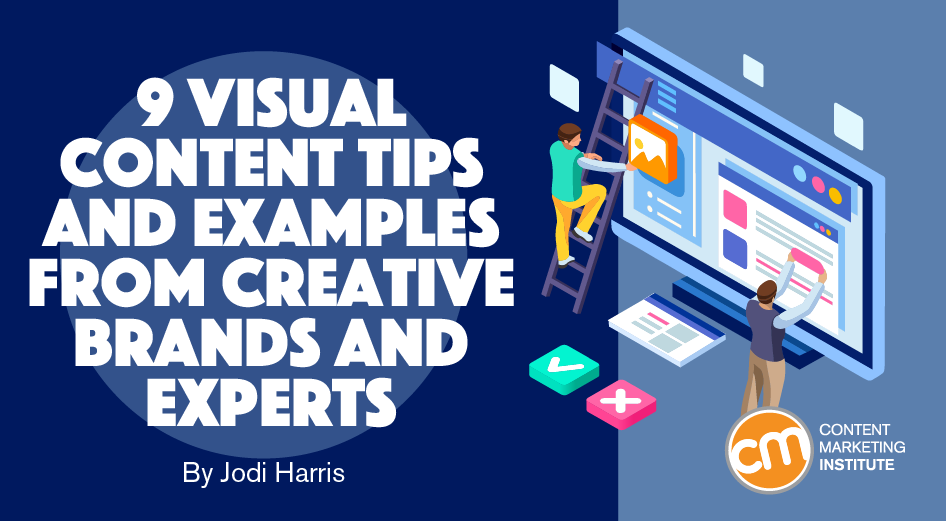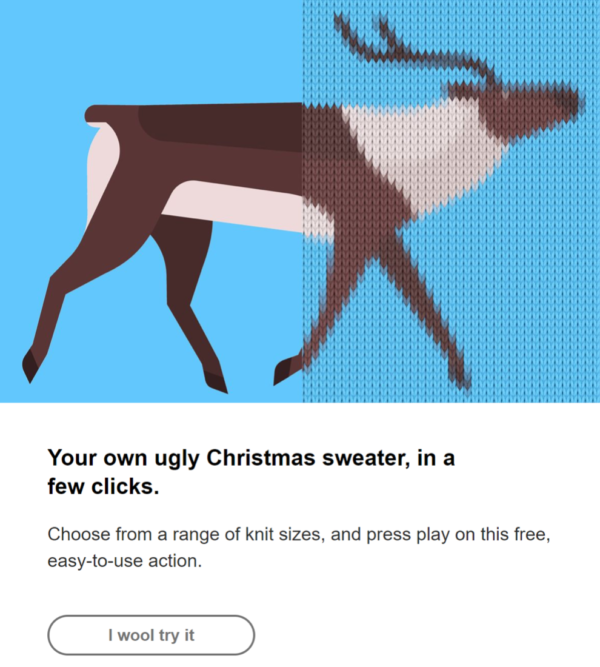Updated March 30, 2022
Visuals are essential to creating content that will help your business stand out and draw in an audience. Not only does imagery help make text-centric content more eye-catching, digestible, and memorable, but it can communicate compelling messages that speak volumes without any text.
Visual trends and creative platforms come and go in the blink of a smartphone camera’s eye. Take a fresh look at how your brand’s photos, videos, and graphics can do the talking. This collection of best-practice tips comes from some of the industry’s most creative and design-minded content experts. It also includes best-in-show examples to inspire you to put your brand’s vision on display.
Take a fresh look at your brand’s photos, videos, and graphics to get a better focus on your #VisualContent strategy, says @joderama via @CMIContent. Click To Tweet1. Consider the story – not just the visuals
Visual storytelling isn’t just about the pictures. Visuals should enable a clear, consistent story from your brand. Even if each individual visual asset doesn’t tell an obvious story, your audience should be able to follow the narrative thread.
It’s a point CMI’s chief strategy advisor Robert Rose emphasizes in his detailed Marketing Makers lesson on the subject. His top-line advice: Think like a storyteller. Then plan your visual media to represent and relate the story across all your platforms.
Think like a storyteller, then plan your visuals to tell the story across platforms, says @Robert_Rose via @joderama @CMIContent. Click To TweetIt’s a lesson executed skillfully by the mindfulness app Calm. Whether viewing their ads in your Instagram Stories feed or scrolling the daily affirmations and meditations posted to its profile page, the cool blue color palette and serene background scenery create visual reinforcement of the brand’s overarching story of enabling people to find balance in their lives.

2. Align the visual story with your content marketing strategy
Posting a photo or video online and waiting for the business offers to start rolling in is not a strategy. Neither is hinging your visual content success on creating the next viral phenomenon. Like any content marketing format, you need a compelling rationale for visual storytelling and a clear plan for turning views into meaningful marketing results.
Posting a photo or video online and waiting for the business offers to start rolling in is not a strategy, says @joderama via @CMIContent. Click To TweetBefore your creative team sketches any ideas, make sure they answer these questions:
- What are we trying to accomplish with our visual content?
- Who are our audience members? What kinds of content experiences interest them?
- What problems does our organization solve?
- What is our clearly defined vision of what makes our brand unique? How can we communicate those messages in a compelling and visually consistent way?
- What metrics will we use to measure success? For which terms should this image appear in search engine results?
To ensure your visual vision aligns with your marketing purpose, let audience preferences – not your gut feelings – guide the selection of themes, topics, and approaches.
For example, a current rule of thumb dictates videos should run between 30 seconds and six minutes. However, video pro Andrew Davis rarely creates videos less than seven minutes.
To find audience insights to guide your creative decision-making, Andrew suggests tracking:
- Audience retention rates: Compare the retention rates for each video. For example, one of his popular videos showed a 50% retention rate – half who viewed the video watched until the end. When videos fail to meet that retention rate, he does a deeper dive into their creative and technical details – length, topic, title, and tags – to discern what didn’t work well.
- Subscriber responses: Track direct replies to those who subscribe to your content. Andrew includes links to his videos in Loyalty Loop, a weekly email newsletter. “Lots of people click, open, and watch it, but the people who respond – especially when it’s about something that really hit a chord – help me understand what’s working because it tells me what they’re liking, what’s challenging them, and what are they learning,” he says.
- Comments: Read responses posted below the videos. Andrew mines the comments viewers leave on the YouTube page and below his LinkedIn posts where he shares the link.
TIP: If you’d like more guidance on building a strategic framework to support all your content efforts, this three-step content marketing strategy tutorial can help.
3. Ensure images reflect and represent your whole audience
Images might speak a thousand words, but those words do not necessarily convey the same message to everyone – especially those who aren’t represented authentically in your brand’s visual stories.
African-American Marketing Association founder Michelle Ngome implores marketers to consider diversity in their content creation. “What kinds of content are you sharing on Instagram, Facebook, LinkedIn company pages, and Twitter? What do your messaging and images look like? Is there a healthy balance of perspectives shared in [your] choices of topics and the [faces and voices behind] your messages?… Does it prioritize the experiences of some groups over others?” Michelle asks.
A lot of organizations are diverse but are they inclusive, asks @MichelleNgome via @joderama @CMIContent. Click To TweetMichelle points to Rihanna’s lingerie brand Savage X Fenty as a shining example. She credits the brand’s broadly inclusive visualization model as a key reason it reached a $1 billion valuation just two years after launching. You can see evidence of that in a Valentine’s Day post shared on Instagram and Facebook emphasizing that sexy isn’t based on age, skin color, or sexual preference.
Keep in mind: Diversity doesn’t need to be the focal point of a visual story for it to play a key role. In fact, normalizing the representation of diverse communities as part and parcel of your creative process means you won’t have to think about it on an asset-by-asset basis. It will happen organically. That’s a goal GLAAD, Getty Images, and Ceros are working to further with their collaborative initiative Seeing is Believing.

A Getty Images’ Visual GPS 2021 Study found countries with greater representation of the LGBTQ+ community in their media and advertising exhibit less discrimination and less bias. The resulting partnership was forged to “elevate diverse narratives that can alter perceptions, evoke empathy, and build community.” The effort included a calendar of LGBTQ+ celebration days and a gated Visual Storytelling Guidebook to inspire increased inclusion and thoughtful portrayals of the LGBTQ+ community. Getty also compiled special collections of stock images emphasizing intersectionality and authenticity over the narrow, stereotypical depictions commonly seen in media.
4. Use your fans’ content – or let them do the work for you
Consumers love to snap pictures and share selfie videos with their friends. Instead of interrupting their experience with product shots and promotional pitches, why not include their creative work in your content marketing?
In a recent Teen Vogue article, Abercrombie & Fitch explains how it turned to the TikTok community for help shedding its early 2000s “preppy surfer” look. While the company ran sponsored ads and partner posts on the platform, much of the credit for its successful refresh is owed to the Gen Z consumers who posted their own videos tagged with #AbercrombieHaul and #AbercrombieStyle.
For example, Teen Vogue points to Andy Lobos’ TikTok video about Abercrombie’s logo-less hoodies, which earned over 1 million views. Once an Abercrombie product goes viral on TikTok, it typically sells out on the site.
@andy_lobosReply to @gunnawut surprisingly there is no logos on this just a good blank hoodie #fyp #abercrombie♬ original sound – led
5. Stay on brand
Whether fans are involved in your imagery or not, take steps to maintain your brand’s visual identity, including the use of corporate colors and logos. Ideally, all your content assets feature a consistent visual design – one that viewers instantly recognize no matter where the content appears or who creates it.
For example, Planters decided to sit out the 2021 Super Bowl ad frenzy in favor of a cause-based play to promote “little acts of extraordinary substance that make the world a better place.” But despite benching its ad, the brand didn’t bench its signature colors or its resurrected mascot in its videos and social media posts about the campaign:
For example, embedded links can be problematic if not used appropriately. Visual content strategy expert (and avowed comics geek) Buddy Scalera says a platform’s native tools might pick a less-preferred image from the content to display as the thumbnail or preview, or they might crop it in a way that robs some of its resonance and branding elements. As a workaround, he suggests using Open Graph tags – a piece of code that gives you greater control of the visual experience you’re trying to create.
Content marketers should wrest control of their visuals from @Microsoft, @Google, @Facebook, says @BuddyScalera via @joderama @CMIContent. Click To TweetTIP: Don’t forget to add your logo to original images and tag them with relevant keywords, categories, hashtags, and metadata. This helps your fans find your content even when shared in unfamiliar contexts.
6. Tailor visuals to the delivery platform
You also need to consider each sharing environment to determine how well the visuals fit the conversational context and audience preferences. Of course, with the right insights, your visuals can find an audience in places you wouldn’t expect to be a good fit.
For example, the Instagram audience might not seem like an obvious fit for the long-form literature at The New York Public Library. But its content team translated a series of text-heavy content into snackable visual segments that deserve a special place on its shelves of great works.
Insta Novels visualizes five iconic novels as Instagram Stories. Each edition includes the full text along with illustrations and an animated intro. It even includes a place to pause on every frame for those who aren’t skilled at reading in the platform’s 15-second increments. These visualized novels gained more than 300,000 views and added more than 140,000 followers to the library’s Instagram account.

HANDPICKED RELATED CONTENT:
7. Don’t be afraid to get emotional
Some of the most memorable visual experiences tap into the power of emotion. Need proof? I challenge you to watch this emotionally charged video from Oreo and not get a little misty-eyed at the display of fatherly love and acceptance:
This level of deliberate planning also helped the U.S. Humane Society catch the eyes of the 2021 Content Marketing Award judges, which recognized All Animals as a finalist in the Best Feature Design and Best Use of Photography categories and the winner for Best Nonprofit Publication.

Famed photographer Pete Souza captured plenty of posed snapshots while documenting the presidencies of Barack Obama and Ronald Reagan. Yet, in his keynote address at Content Marketing World 2021, Pete shared his most enduring images that say something essential about the person behind the institution.
He included many of those photographs in his two best-selling books, Obama: An Intimate Portrait and Shade: A Tale of Two Presidencies. “The way [Obama] interacted with other people showed what he was like as a human being,” Pete told the crowd.

8. Repurpose information and insights as visuals
A stock-image service can be a viable alternative when cutting-edge equipment (and the talent to operate it) is out of your price range. The key? Put your brand’s spin on the images before you publish them.
You also can “skin” your brand’s content without going the stock route, many of which might offer a stronger balance between cost-effectiveness and audience impact.
For example, in a content partnership with Quartz, Deloitte Global enlisted its creative services studio to help turn its lead-gen white paper on the millennial work experience into a highly immersive interactive version anchored by vibrant full-screen illustrations.
The cast of characters for The Resilient Generation was established with a drawing of an apartment and its inhabitants. Then, artist Paige Vickers created lush, individual scenes with whimsical details. She depicted three typical young professionals at home mid-pandemic — working next to a roommate, taking a mental health break with the dog, and preparing for a climate protest.

The original artwork might have been more expensive than stock art, but the investment paid off. A week after launch, Deloitte’s page visits grew approximately 964%, and white paper downloads increased 33%. It was also a hit with the 2021 Content Marketing Award judges, too, capturing the win for Best Use of Illustration.
9. Follow the patterns of effective design
A wealth of DIY design tools online and on social media gives almost anyone the ability to produce visual content. However, those tools still require some design chops to create clear, compelling, and readable images and videos.
That process can be simplified with design templates. That was the idea behind a holiday email campaign from Adobe Creative. It offered its newsletter subscribers intriguing ugly Christmas sweaters Photoshop templates. Customers could turn their favorite images into a virtual sweater pattern with just a few clicks.
Adobe’s newsletters also featured templates for cozy winter cards, as well as non-holiday options like how to make a risograph-style print in Photoshop.
Sharing visual content that helped Adobe’s audience create their own was a smart marketing play. It got creators to experiment with Photoshop’s tools and features while providing step-by-step instructions and delivering a free holiday gift of surprise and delight.
Audiences love free things – templates, tools, and images make great #content and great #email subscriber gifts. See examples from the @AdobeCreate newsletter via @joderama @CMIContent. Click To TweetOf course, when working with templates isn’t a viable option, your best bet is to default to the basic principles of good design. Here are a few to keep in mind:
- Give your imagery room to breathe: Failing to leave enough white space between visuals can make a page cluttered and hard to follow. Remove images that don’t add to the visual conversation and expand the space between unrelated elements to clarify page structure.
- Don’t get color-blindsided: Stay true to your branding guidelines, including color preferences. But don’t get so caught up in executing this priority that you overlook whether those colors will work well together online. Pick one color to use as a base, then find complementary colors with an online color-wheel tool.
- Speed up your page loads: Visual experiences are slowed when images aren’t properly sized and compressed. Use tools (like this simple one from Google) to check how quickly images load. If it’s too long, adjust for consumption on different platforms and devices, including mobile.
- Make good typography decisions: Not only is choosing the proper font size, weight, and spacing critical to readability, but poor typography decisions can conflict with crafting understandable and memorable messages.
TIP: Don’t forget to get your visuals shared as far and wide as all your other assets. Influencers can be instrumental to this goal, especially on social media. Make it easy for them by offering multiple options – such as tagging them on social media or providing direct access to the raw files for download.
How do you visualize your brand’s story?
Of course, these ideas are just the tip of the iceberg. You’ll find more image-centric inspiration in CMI’s content hub on the subject. We also would love to hear how other businesses are painting pictures of marketing success. Tell us about your favorites in the comments.
All tools mentioned in the article are identified by the author. If you have a tool to suggest, please feel free to add it in the comments.
Cover image by Joseph Kalinowski/Content Marketing Institute



